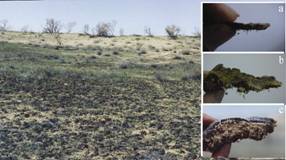The Study on the Role of Nonphotosynthetic Microbes in the Recovery of Biological Soil Crusts in the Gurbantunggut Desert, Northwestern China Made Progress
2011-05-04
In recent years, much interest has been focused on the formation and recovery of Biological Soil Crusts (BSCs) in desert ecosystems. However, few studies have specifically described the primary, nonphotosynthetic, bacterial colonizers and fungal colonizers associated with the formation of BSCs.
Dr. Nan WU, Xinjiang Institute of Ecology and Geography, Chinese Academy of Sciences, investigated the mechanisms regulating the recovery of BSCs due to the presence of nonphotosynthetic microbes using a soil scalping technique. Microscopic examinations identified the “glue” and “rope” action of bacteria and fungi at the initial stages of recovery of BSCs prior to the appearance of cyanobacteria. Extracellular polymeric substances (EPS) excreted by bacteria principally contained glucose and mannose. Crust-forming tests in the laboratory and in the field demonstrated that inoculation of bare sand with oligotrophic bacteria was effective in accelerating the recovery of BSCs. The number of nonphotosynthetic microbes (especially actinomycetes and fungi) recorded in both the crust layer (0–2 cm) and subsurface layer (2–5 cm) was higher after 3 years than after 1 year. Microbial spatial variability of BSCs was related to nutrient status, especially available N.
The results was published in the Arid Land Research and Management, 2010, 24: 42-46. Doi: 10.1080/15324980903439503.

Figure 1 Landscape of the Gurbantunggut Desert (left) and different types of BSCs (a: algae dominated crust; b: lichen dominated crust; c: moss dominated crust)



